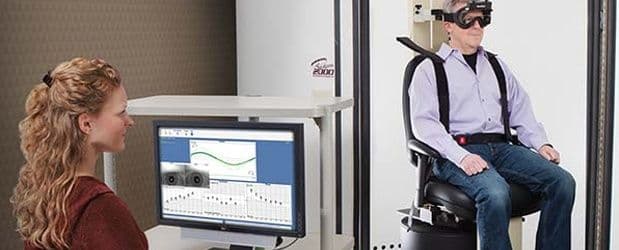Enhance Your Rehab Program With Rotational Chairs

Most therapists stick to tried and true methods when assessing patients suffering from vestibular issues. They remain unaware of the many ways using a rotational chair widens the scope of options available to help obtain a correct diagnosis, leading to the development of more effective treatment plans.
Traditional Vestibular Rehabilitation Therapy
Inner ear and balance (vestibular) issues cause patients to experience the following disorders:
- Visual Issues
- Dizziness
- Vertigo
- Trouble maintaining their balance
Vestibular rehab helps patients by teaching them different exercises customized to address the problems they’re experiencing. The brain learns to use other senses and functions to compensate for those affected by the disorder.
Incorporating Rotatory Chairs
Patients being evaluated for vestibular issues undergo thorough testing to evaluate the scope of the symptoms being experienced. This includes assessment of the vestibulo-ocular reflex (VOR). Many therapists use caloric testing to determine how well the peripheral vestibular system functions.
Warm, cool, or icy water is dropped into the ear while the patient’s response gets measured. This method typically produces rotational stimulation at a 0.002-0.004 Hz frequency. This level isn’t significant enough to pinpoint issues experienced at higher frequencies.
Using this test on people born with vestibular disorders can produce irregular or abnormal results. This requires the therapist to conduct an additional test to verify the patient’s VOR state.
Rotatory Chair Therapy Types
Rotational chairs help physical therapist perform more effective testing for VOR issues. Rotatory chair testing produces frequencies in the 0.01-1.28 Hz range. Since the first application of a rotatory chair in 1907, significant advances have been made in the types of tests therapists can perform with the chair.
Most applications of Rotational chair therapy have been for checking horizontal canal vestibuloocular reflex (VOR). The two most common uses are:
- Diagnosing patients with peripheral vestibular lesions
- Monitoring patients with Ménière syndrome currently undergoing pharmacologic vestibular ablation
How Tests are Conducted
Therapists place electrodes at the corner of each of the patient’s eyes to record results. The patient sits in the rotary chair – usually located in a lightproof booth with a two-way communication system and infrared camera – while the electrodes get connected to a computer to study how the nystagmus reacts during testing.
Testing Methods
**Constant angular acceleration **– The chair accelerates and decelerates at constant speeds. Patients with vestibular dysfunction have thresholds around 6-7°/s2, while healthier patients come in at 1°/s2.
Impulse angular acceleration – The chair accelerates for a period of time, then comes to a sudden stop. This lets therapists assess the state of VOR for each side independently when the test is conducted in different directions.
Step test angular acceleration – The chair accelerates at 100°/s2 to a new level, continuously rotating between each step. This test allows therapists to separate people suffering from a unilateral vestibular deficit from those that aren’t.
Sinusoidal harmonic angular acceleration – The patient is rotated in alternate directions using one or multiple frequencies. This is more complex than the other methods and can lead to discomfort for the patient. The therapist looks for symmetry in the responses for each of the directions the patient is rotated into.
Other Applications For Rotatory Chairs
Recent use of the rotational chair has moved beyond basic VOR testing and into other applications, including:
Optokinetic After-nystagmus (OKAN) – Checks for the level of nystagmus that remains after removing a patient from an optokinetic field. It’s also good to use on people experiencing visual issues after a sea voyage.
Off-vertical axis rotation – Still experimental, this application tilts the patient to a point that’s beyond vertical and then rotated sinusoidally. This allows for independent testing of the otolithic function that produces little nausea.
A Wider Range Of Assessment Options
Rotational chairs give you more options to evaluate the cause and severity of a patient’s condition. This helps you design the best treatment plans to provide them with the relief and day to day functionality they desire.
Learn More
